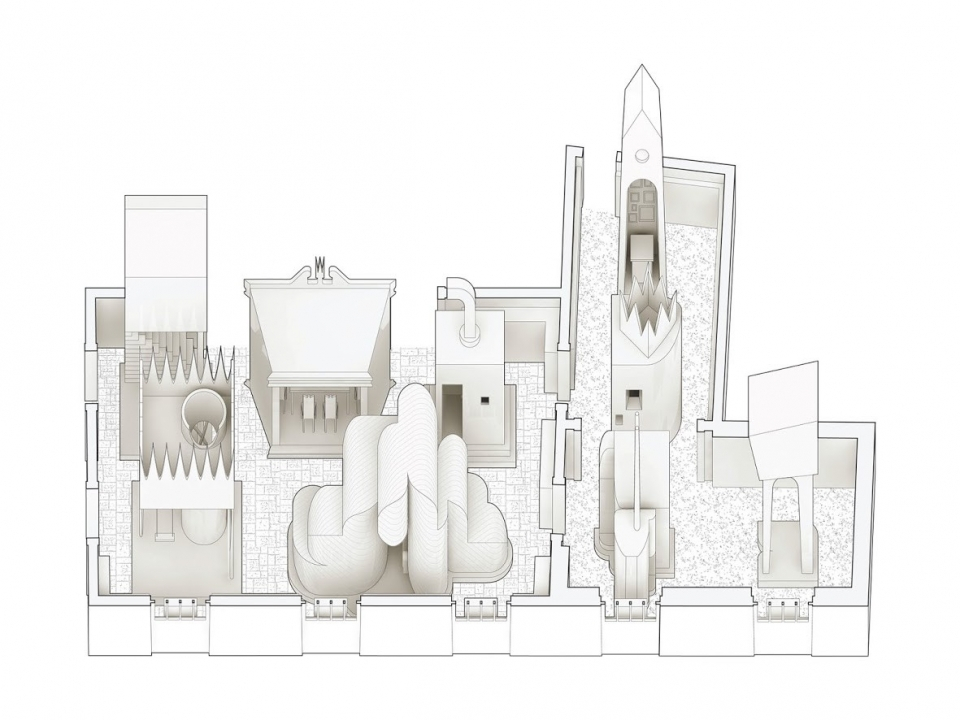Interview with Jimenez Lai
Jimenez Lai leads Bureau Spectacular, an architecture and design practice based in Los Angeles. His work spans many disciplines including the publication of an architectural graphic novel Citizens of No Place and the curation of exhibitions that include the Taiwan Pavilion at the 14th Venice Biennale.
Through his practice, Lai tells stories by drawing them in the form of a crisply composed, eye-catching manga comic in which he turns fake realities into tangible architectural objects of varying scale. These objects, which look colorful and alien to the spectator, set the scene for awfully familiar characters such as the prehistoric human to the citizens of the future. Somewhere between the object and the character is where Lai uses architecture to tell his stories.
....
KB: Bureau Spectacular is presented as one that "imagines other worlds" and tells stories, which sometimes involve "fake realities that invite enticing possibilities". How does fiction empower you as an architect and what role does it play in your work?
JL: The notion of multiverse is a powerful idea. Somewhere out there in another parallel universe, there is another you and another me where we made a few different decisions. DC Comics thrived on the retelling of stories with the multiple earths, where there could be a few different Batmans who may or may not use guns, as they may or may not kill. Another approach to this thought is the Rashomon Effect - the same story can be retold from different perspectives, but how a story is retold becomes the content.
During one of Michael Speaks' lectures, I was exposed to the book On Bullshit by Harry G. Frankfurt. I quickly gravitated towards the central thesis of this book, which was a discussion about the distinction between lying and bullshitting. According to Frankfurt, the act of lying acknowledges the presence of truth, because a lie deliberately conceals or distorts truth. Bullshitting, on the other hand, does not require the presence of truth. It is an act of projecting a story about what something could be, whether or not that something is there yet. Architects do this professionally - working with factual sites, architects produce fictional matter on paper. These fictions, often in the format of drawings, are then submitted to the city hall for approval, and sometimes become as real as concrete.
Based on this train of thought, "other realities" or the production of many options for temporarily suspended decisions became a methodology of working. Particularly, the cartoon page became a fertile surface towards this effort: every frame a portal, every bubble a speech act. The name "Bureau Spectacular" was even designed so that its acronym "BS" could become a constant reminder of Speaks and Frankfurt's thesis.
With all this being said, the recent political climate in 2016 and 2017 has given me a reason for second thoughts. I am realizing this argument only worked during a time of political stability when power was in the hands of sensible people who respected truth. I have decided to embark on a new journey that takes on the opposite disposition of people currently in power as I will commence a new project that is mostly based on normalcy and facts to combat the unsteady toxins hovering in the low clouds.
KB: Your projects are based on several layers of theoretical framework and often embody irony-filled critique of stagnant architectural theories. How does historical and contemporary architecture discourse influence and shape your work?
JL: Embedding references like Easter Eggs (that are consciously hidden in order bring joy when finding them) and offering the possibility for multiple re-readings is something that storytellers do. Architecture tells stories. As a physically constructed object that captures many aspects of human endeavor, architecture performs the role of documentation and communication of humanity. It allows the details and traces of thoughts to reach very specific keen readers - details that only few kindred spirits would pick up. From drawing, writing, building, or photographing, there are several platforms to represent opportunities to quote other thinkers and construct a larger argument with architecture. I like the work of Andrew Kovacs for this reason - he curates his historical references, and chooses who he performs a dialogue with. Or, for that matter, the work of Quentin Tarantino - he is able to pay homage and produce commentaries upon the work he bases his work on. I decided to construct a list of people I want to think about or talk about, because that itself is an act of design.
For instance, our recent exhibition insideoutsidebetweenbeyond at SFMOMA was based on this train of thought. The exhibition is based on a drawing that SFMOMA recently collected by the same title. It was a drawing based on many other drawings, including the Diamond House (Hejduk), Moriyama House (SANAA), micromegas (Libeskind), Manhattan Transcripts (Tschumi)…
....
